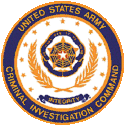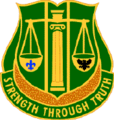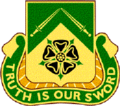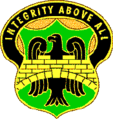United States Army Criminal Investigation Command
The United States Army Criminal Investigation Division Command (USACIDC) investigates felony crimes and serious violations of military law & the United States Code within the United States Army. The command is a separate military investigative force with investigative autonomy; CID special agents report through the CID chain of command to the USACIDC Commanding General, who reports directly to the Chief of Staff of the Army and the Secretary of the Army. By position, the USACIDC commanding general is also the Army's Provost Marshal General.
| United States Army Criminal Investigation Division Command | |
|---|---|
 U.S. Army Criminal Investigation Division Command Seal | |
 CID special agent badge | |
| Motto | “Do What Has To Be Done” |
| Agency overview | |
| Formed | September 17, 1971 |
| Employees | 2,000 |
| Jurisdictional structure | |
| Federal agency | United States |
| Operations jurisdiction | United States |
| General nature | |
| Operational structure | |
| Headquarters | Marine Corps Base, Quantico |
| Special Agents | 900 |
| Agency executive |
|
| Parent agency | Department of the Army |
| CID Commands | 5
|
| Website | |
| http://www.cid.army.mil | |
Overview
The command does not charge individuals with crimes; instead, CID investigates allegations and turns official findings over to the appropriate command and legal authority for disposition and adjudication. CID exercises jurisdiction over military personnel who are suspected of offenses under the Uniform Code of Military Justice, as well as civilian personnel when there is probable cause to believe the person has committed an offense under the criminal laws of the United States with a nexus to the U.S. Army. CID special agents may be military personnel (NCOs or warrant officers), or appointed civilian personnel.
Within the United States Army, CID has exclusive jurisdiction in the investigation of all serious, felony level crimes with the exception of certain national security crimes such as espionage, treason, and certain aspects of international terrorism. Investigative jurisdiction within the Army of these crimes resides with U.S. Army Counterintelligence (ACI), although joint and parallel investigations can and do happen depending on specific circumstances (most commonly with terrorism investigations).[1]
USACIDC was established as a United States Army command in 1971 and is headquartered at Marine Corps Base, Quantico, Virginia. Worldwide, the organization has slightly fewer than 3,000 soldiers and civilians, of whom approximately 900 are special agents. The initialism "USACIDC" is used to refer to the Army command itself, while criminal investigation personnel and operations are commonly referred to using the shortened initialism "CID", which has its history in the original Criminal Investigation Division formed during World War I and is still retained today for continuity purposes.
History
During World War I, General John J. Pershing ordered the creation of a separate organization within the Military Police Corps to prevent and detect crime among the American Expeditionary Force in France. The newly created Criminal Investigation Division (CID) was headed by a division chief who served as the advisor to the Provost Marshal General on all matters relating to criminal investigations. However, operational control of CID still remained with individual provost marshals, and there was no central control of investigative efforts within the organization, resulting in limitations. At the end of the war, the United States Army was reduced in size during the transition to peacetime and the size of CID shrank dramatically.
With the onset of World War II in December 1941, the armed forces rapidly swelled in size and the Army once again became a force of millions, and the need for a self-policing law enforcement system rematerialized. However, by early 1942, investigations of crimes committed by military personnel were still considered to be a "command function" to be conducted by local military police personnel. The Office of The Provost Marshal General felt that the agents in the Investigations Department were not properly trained for criminal investigations, the only investigations taking place at the time being personnel security background investigations for individuals being considered for employment in defense industries. As the Army had expanded, the crime rate had risen, and local commanders did not have the personnel or resources to conduct adequate investigations. By December 1943, the Provost Marshal General was charged with providing staff supervision over all criminal investigations, and a month later in January 1944, the Criminal Investigation Division was reestablished under the Provost Marshal General's Office. The organization exercised supervision over criminal investigation activities, coordinated investigations between commands, dictated plans and policies, and set standards for criminal investigators.
After the war, the CID was once again decentralized, with control of criminal investigations transferred to area commands in the 1950s and further down to the installation level in the 1960s. A Department of Defense study in 1964 entitled Project Security Shield made clear that complete recentralization of the Army's criminal investigative effort was needed in order to produce a more efficient and responsive worldwide capability. Beginning in 1965, criminal investigative elements were reorganized into CID groups corresponding to geographical areas in the United States. In 1966, the concept was introduced to units in Europe and the Far East. However, this arrangement did not fully resolve all the coordination problems, and in 1969, the U.S. Army Criminal Investigation Agency was established to supervise all CID operations worldwide.
As the agency did not have command authority, in March 1971, Secretary of Defense Melvin Laird directed the Secretary of the Army to form a CID command with command and control authority over all Army-wide CID assets. On 17 September 1971, the United States Army Criminal Investigation Command was established as a major Army command, vested with command and control of all CID activities and resources worldwide.
Selection and training
Military Special Agent candidates must be currently serving in the active Army or Army Reserve. There are no active Army National Guard CID units. Candidates must be enlisted soldiers who are US citizens, at least 21 years of age, and in the ranks of SPC-SGT or SSG with less than 12 months time in grade, and a graduate of the Basic Leader Course (BLC). Candidates must have had at least two years of military service, but not more than 12, at least one year of military police experience or two years of civilian law enforcement experience and a minimum of 60 college credit hours. Other requirements include (but are not limited to) credit checks, no physical limitation, and have the ability to deploy worldwide, normal color vision, the ability to obtain a Top Secret clearance, a drivers license and no history of mental or emotional disorders. Some requirements may be waived.[2]
To qualify for Warrant Officer positions, candidates must be at least a Sergeant/E-5, currently serving as a Special Agent, with 2 years of investigative experience with CID, have a Top Secret clearance and a bachelor's degree (waiverable). Candidates must have also demonstrated leadership potential, management abilities and good communication skills.[2]
CID does not employ Commissioned Officers as Special Agents. CID Battalions and Groups are commanded by Commissioned Officers from the Military Police Corps. These officers do not supervise the conduct of criminal investigations. Criminal investigations are conducted by field Special Agents and are typically supervised by senior Special Agents.
Military Special Agent candidates initially receive training at the US Army Military Police School (USAMPS) at Fort Leonard Wood where they attend the Apprentice CID Special Agent course.[3][4] Later, agents may return to USAMPS to attend specialized training in Advanced Crime Scenes, Sexual Assault Investigations, Child Abuse Prevention and Investigative Techniques, Protective Service Training as well as other subjects.[3][4]
Mission

The primary mission of the CID, according to the organization's website,[5] is to:
- Investigate serious felony level crime (murder, rape, kidnapping, child abuse, drug trafficking, weapons smuggling, etc.)
- Conduct sensitive and/or serious investigations
- Collect, analyze and disseminate criminal intelligence
- Conduct protective service operations
- Provide forensic laboratory support
- Maintain Army criminal records
Additionally, CID may perform the following special missions:
- Perform logistical security, from manufacturers to soldiers on the battlefield
- Develop criminal intelligence to develop countermeasures to combat subversive activities on the battlefield
- Criminal investigations to include war crimes and in some cases crimes against coalition forces and host nation personnel
- Protective service operations for key personnel on and off the battlefield
Organization

In addition to United States Army Criminal Investigation Command headquarters at Marine Corps Base, Quantico, Virginia, CID commands six major subordinate organizations.
![]()
- 3rd MP Group (CID), Hunter Army Airfield, Georgia


- 502nd MP Battalion (CID), Fort Campbell, Kentucky
- Fort Benning Battalion (CID), Fort Benning, Georgia
- Washington Battalion (CID), Fort Myer, Virginia
- 12th MP Detachment (CID), Fort Lee, Virginia
- 68th MP Detachment (CID), Fort Meade, Maryland
- 75th MP Detachment (CID), Fort Belvoir, Virginia
- 6th MP Group (CID), Fort Lewis, Washington



- 701st MP Group (CID), Marine Corps Base, Quantico, Virginia
- Field Investigative Unit
- Major Procurement Fraud Unit, Marine Corps Base, Quantico, Virginia
- US Army Protective Services Battalion, Fort Belvoir, Virginia
- Major Cybercrime Unit, Marine Corps Base, Quantico, Virginia
- Terrorism and Criminal Investigation Unit (TCIU)
- U.S. Army Criminal Investigation Laboratory, Fort Gillem, Georgia
- U.S. Army Crime Records Center, Marine Corps Base, Quantico, Virginia
Uniform
Military CID agents continue to be soldiers of the Military Police Corps. For official photographs, and certain duty assignments, they wear the uniforms, rank and insignia of any other soldier of their respective ranks. The design of the shoulder sleeve insignia has the central star and the lines of latitude and longitude suggesting a globe. Together with the arrowheads, they mark the points of a compass, symbolizing the basic worldwide mission of the command: To perform and exercise centralized command authority, direction and control of Army criminal investigation activities worldwide. Red, white, and blue are the national colors. The CID distinctive unit insignia has a central star symbolizing centralized command. The grid lines allude to the latitude lines of the globe, thus referring to the worldwide activities of the organization. The grid lines also suggest a stylized web, with eight sides representing the original eight geographical regions of the command. The web, a symbol of criminal apprehension, is the result of methodical construction alluding to the scientific methods of criminal investigations. The outer points of the star further symbolize far-reaching authority. Red, white, and blue, are the national colors and gold is symbolic of achievement.[6]
As criminal investigators, CID Special Agents typically dress in civilian clothing which range from professional suits, business/casual attire, or comfortable clothing when appropriate for their daily investigative responsibilities. Due to the nature of their work, undercover assignments dictate further variations of attire to support specific undercover mission requirements.
When deployed to certain combat environments, and during other special times and circumstances, CID agents wear Army Combat Uniforms, replacing rank insignia with subdued versions of officer "U.S." collar brass and sometimes wearing "CID" brassards on their upper left arms.
Firearms
CID Special Agents are issued the 9mm Sig Sauer P320 sidearm, designated "M18" or the Sig Sauer P228, designated "M11." For combat environments, Agents are also issued the M4A1 Carbine or shortened version, MK18, for protection missions,[7][8] a short, lighter version of the M16 Rifle.
Commanders
- Colonel Henry H. Tufts, September 1971 - August 1974
- Major General Albert R. Escola, August 1974 - September 1975
- Major General Paul M. Timmerberg, September 1975 - September 1983
- Major General Eugene R. Cromartie, September 1983 - April 1990
- Major General Peter T. Berry, July 1990 - June 1995
- Brigadier General Daniel A. Doherty, July 1995 - September 1998
- Brigadier General David Foley, September 1998 - June 2001
- Major General Donald J. Ryder, June 2001 - July 2006
- Brigadier General Rodney L. Johnson, July 2006 - January 2010
- Brigadier General Colleen L. McGuire, January 2010 - September 2011
- Major General David E. Quantock, September 2011 - September 2014
- Major General Mark S. Inch, September 2014 - May 4, 2017
- Major General David P. Glaser, May 4, 2017 – June 24, 2019
- Major General Kevin Vereen, June 24, 2019 - Present
In popular culture
- The 2005 novel by Lee Child entitled One Shot tells the story of Jack Reacher an Army CID special agent.
- The GI Joe character Chuckles (G.I. Joe) is an Army Military Police / CID Special Agent.
- The 1992 novel by Nelson DeMille titled The General's Daughter tells the story of Army CID Special Agent Paul Brenner. The book was made into a movie of the same name starring John Travolta in the role of Brenner.
- The 2003 film Basic (film) has the character Army Captain Julia Osborne, played by Connie Nielsen investigating a murder.
See also
Federal law enforcement
- Criminal Investigation Task Force (CITF)
- Gendarmerie
- Carabinieri
- List of United States federal law enforcement agencies
- Military Police
- Policing in the United States
- Shore Patrol
- Special Agent
JAG Corps
- United States Army Judge Advocate General's Corps
Other Military Investigative Organizations
- United States Army Counterintelligence (ACI)
- Naval Criminal Investigative Service (NCIS)
- United States Air Force Office of Special Investigations (AFOSI or OSI)
- United States Marine Corps Criminal Investigation Division (USMC CID)
Other
References
- "Army Publishing Directorate".
- "Join CID". USACIDC. Archived from the original on 27 July 2009. Retrieved 3 August 2009.
- "Special Agent Training". USACIDC. Archived from the original on 29 July 2009. Retrieved 3 August 2009.
- "Bravo Company 701st MP BN". USAMPS. Retrieved 3 August 2009.
- "Cid.army.mil". Cid.army.mil. Archived from the original on 21 May 2011. Retrieved 21 May 2011.
- "Cid.army.mil". Cid.army.mil. 17 September 1971. Archived from the original on 29 May 2011. Retrieved 21 May 2011.
- Miklos, Timothy (April 2006). "History in the Making" (PDF). US Army MP Bulletin. Archived (PDF) from the original on 24 March 2009. Retrieved 5 July 2009.
- "Military Police Detachment (CID) TOE". U.S. Army. Archived from the original on 24 December 2008. Retrieved 5 July 2009.
- http://www.cid.army.mil/history.html
